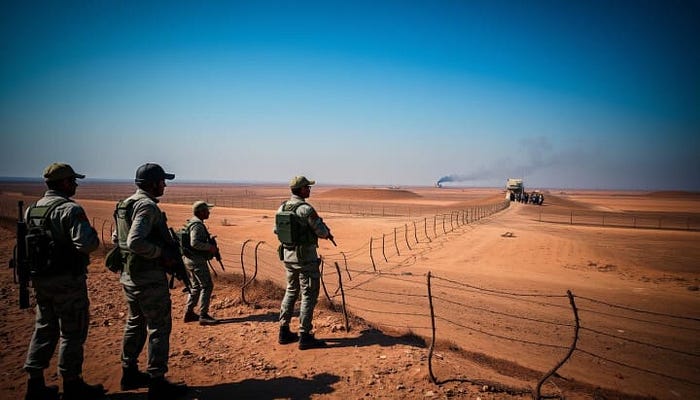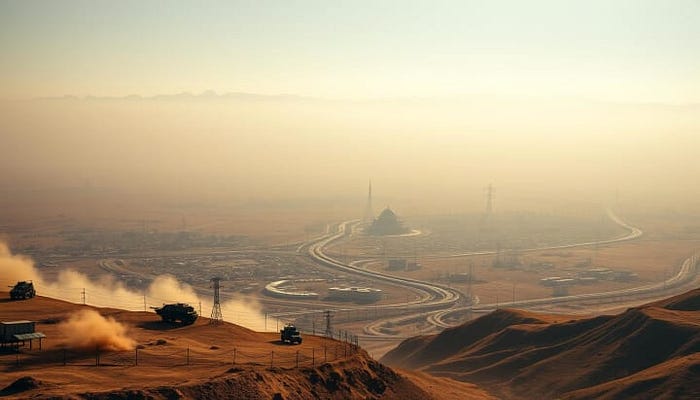The long fight between Pakistan and India started when British India split in 1947.

This split made two new countries. But it also caused fights, mainly over Kashmir. This has led to many wars and small fights between these two powerful neighbors.
This fight has hurt many people, cost a lot of money, and made the area unstable. It’s a big and long-lasting problem that has lasted for many years.
Key Takeaways
- The conflict between Pakistan and India started with the split of British India.
- The Kashmir region is a big problem.
- Many wars and small fights have happened because of this.
- Both countries have nuclear weapons, making the fight very serious.
- The fight has caused a lot of harm and cost a lot of money.
Historical Roots of the Pakistan-India Conflict
Understanding the history of the Pakistan-India conflict is key. It involves politics, society, and culture. These factors have grown over time.
Partition of 1947: The Birth of Two Nations
In 1947, India was split into two countries: India and Pakistan. This was based on Hindus and Muslims having their own lands. The Muslim League, led by Muhammad Ali Jinnah, pushed for this.
This split caused a huge migration. Over 14 million people moved, and many died. This event has left a lasting impact on their relationship.
The Human Cost of Division
The partition was very hard on people. Millions were displaced and families were torn apart. Many never saw each other again. The violence and loss of property were huge.

Kashmir Dispute: The Heart of the Conflict
The Kashmir dispute is at the core of the conflict. Both countries want all of Kashmir. After the first war, the region was split. The Line of Control (LoC) is now a de facto border but causes tension.
The Kashmir issue has led to many wars. These wars have caused a lot of suffering and cost a lot of money. Today, there are protests and skirmishes along the LoC.
Four Wars and Counting: 1947, 1965, 1971, and 1999
India and Pakistan have fought four wars. Most were over Kashmir, except for the 1971 war. This war was about Bangladesh’s independence. These wars have caused a lot of suffering and cost a lot of money.
- 1947: The first war over Kashmir, resulting in the division of the region.
- 1965: The second war over Kashmir, ending with the Tashkent Agreement.
- 1971: The war that led to the independence of Bangladesh.
- 1999: The Kargil War, a limited conflict that highlighted the nuclear dimension of the conflict.
The legacy of these conflicts shapes the Pakistan-India relationship. There are ongoing tensions and periodic escalations.
Understanding the Pakistan vs India War Dynamics
To understand the Pakistan vs India war, we must look at nuclear weapons, the Line of Control, and terrorism. Nuclear weapons make the situation very serious. This makes the balance of terror very important.
Nuclear Neighbors: The Balance of Terror
Both Pakistan and India have nuclear weapons. This adds a new level of danger. It makes both countries think twice before starting a big war.
Doctrines and Deterrence Strategies
India and Pakistan have their own ways to deal with nuclear threats. India says it won’t use nuclear weapons first. Pakistan might use them if attacked.
Nuclear Deterrence Strategies:

Line of Control: Where Tensions Flare Regularly
The Line of Control in Kashmir is very militarized. There are often fights and deaths. This makes the border very tense.

Beyond Conventional Warfare: Terrorism and Proxy Conflicts
The war also includes terrorism and proxy wars. Both sides support groups in the area. This causes a lot of trouble and violence.
Impact on Civilian Populations
Terrorism and proxy wars hurt civilians a lot. Kashmir has seen many human rights abuses. People have been displaced and killed.
The humanitarian crisis in Kashmir shows we need peace fast.
Beyond the Battlefield: Wider Implications
The fight between India and Pakistan affects more than just the battlefield. It impacts global politics and regional stability. This ongoing conflict has big effects on both.

Global Powers and Their Interests in South Asia
Big countries like the United States and China are watching the India-Pakistan fight closely. They all have big interests in South Asia. This makes the situation even more complicated.
The United States tries to keep peace in the area. It wants to fight terrorism but also keep good relations with both countries. China, though, is getting closer to Pakistan. This is through projects like the China-Pakistan Economic Corridor (CPEC).
Economic Costs of Perpetual Hostility
Both India and Pakistan spend a lot on their militaries. This means they have less money for other important things. They miss out on chances to grow and improve their lives.
Trade vs. Military Spending
India and Pakistan could trade a lot more if they weren’t fighting. But, they spend too much on war. This stops them from growing their economies.
Starting to trade more could help them get along better. When countries trade, they often work together more.
Cultural Bonds Amid Political Divisions
Even though India and Pakistan fight, they share a lot of culture. They have music, food, and history in common. This shared culture could help them find peace.
Exchanging cultures and people can help bridge the gap. By celebrating what they have in common, they can move towards peace.
Conclusion
The Pakistan vs India war is a long and complex issue. It started with the partition of 1947 and the Kashmir dispute. The use of nuclear weapons makes it even more complicated.
Even with diplomatic talks, finding a lasting peace is hard. The conflict affects not just the region but the world too.
Understanding the history and current situation is key to peace. The world needs to support diplomatic efforts for a peaceful solution.
Both Pakistan and India, along with the global community, must work together. They need to tackle the root causes of the conflict.
FAQ
What is the main cause of the Pakistan vs India war?
The main cause is the fight over Kashmir. This has been a big issue ever sense India and Pakistan split in 1947.
How has the partition of 1947 contributed to the ongoing conflict?
The split led to two new countries, India and Pakistan. It caused a lot of moving and violence. This started a long fight.
What is the significance of the Line of Control in Kashmir?
The Line of Control is a big problem for Pakistan and India. There are often fights and breaks in peace. It’s a key part of the fight.
How have nuclear weapons impacted the Pakistan vs India conflict?
Nuclear weapons have made the fight even more serious. They could lead to very bad things. This makes the fight more complicated.
What are the economic costs of the Pakistan vs India conflict?
The fight costs a lot of money. Both countries spend a lot on the military. This makes it hard for them to grow and improve.
Are there any cultural bonds between the people of India and Pakistan?
Yes, there are strong cultural ties. People in India and Pakistan share a lot. This shows there’s more to the fight than politics.
How do global powers factor into the Pakistan vs India conflict?
Big countries have big interests in South Asia. The fight affects the whole area. This worries countries all over the world.
What is the role of terrorism and proxy forces in the conflict?
Terrorism and proxy forces are used by both sides. They hurt civilians a lot. This makes the fight even harder to solve.
Have there been any diplomatic efforts to resolve the conflict?
Yes, there have been talks to solve the fight. But finding a lasting peace is hard. The problems are very deep.
What is the impact of the conflict on regional stability?
The fight between Pakistan and India affects the whole area. It’s not just about the two countries. It impacts South Asia a lot.


0 Comments